Microcystins-Detoxifying Enzyme (MlrA) in bioremediation of freshwaters from cyanobacterial pollutants
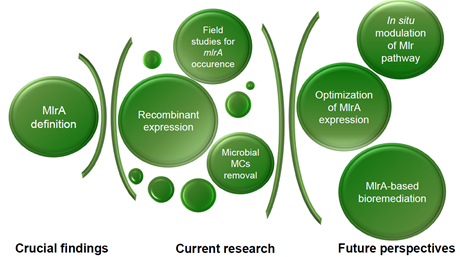 A molecular and biochemical characterisation of the enzymes involved in hepatotoxic cyanopeptide (microcystin - MC) biodegradation was performed in our laboratory by recombinant protein synthesis (Dziga et al, 2012 and Dexter et al, 2018). The production of MlrA (microcystinase that detoxifies cyanotoxin microcystins) in cyanobacterial chassis constitutes a focal point for exploration and development of cyanobacterial synthetic biology. A collaboration with McCormick lab was established (Dexter et al., 2021) to extend our project for better understanding of heterologous protein production in cyanobacterial chassis. The final aim is heterologous production of an industrially relevant enzyme via photoautotrophic biomass from wastewaters.
A molecular and biochemical characterisation of the enzymes involved in hepatotoxic cyanopeptide (microcystin - MC) biodegradation was performed in our laboratory by recombinant protein synthesis (Dziga et al, 2012 and Dexter et al, 2018). The production of MlrA (microcystinase that detoxifies cyanotoxin microcystins) in cyanobacterial chassis constitutes a focal point for exploration and development of cyanobacterial synthetic biology. A collaboration with McCormick lab was established (Dexter et al., 2021) to extend our project for better understanding of heterologous protein production in cyanobacterial chassis. The final aim is heterologous production of an industrially relevant enzyme via photoautotrophic biomass from wastewaters.
Such a product (MlrA) may be utilized as an alternative/complementary factor in cyanobacterial management in lakes and ponds which would eliminate both excess cyanobacteria and hepatotoxic microcystins which they potentially produce and release upon lysis. We showed that the combined use of hydrogen peroxide and MlrA is promising in the elimination of both cyanobacteria and their hepatotoxic heptapeptide in environmental waters (Dziga et al., 2019).
Cyanobacteria-cyanophage interaction
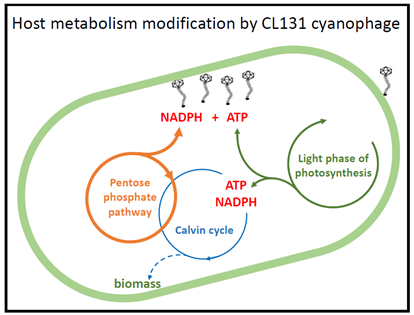 There is growing interest in the investigation of how cyanophages impact the dynamics of cyanobacterial population. Understanding the strategies employed by viruses to ensure effective multiplication is of crucial importance, but information on the physiology of infection remains very limited. Our goal is to comprehensively investigate the cyanophage infection process. In cooperation with dr Sigitas Sulcius (Nature Research Centre, Vilnius) and dr Sarit Avrani (University of Haifa) we attempt to investigate the physiology of the invasive Aphanizomenon flos-aquae (isolated from the Curonian Lagoon of the Baltic Sea) and other freshwater cyanobacteria during viral infection to describe the overall strategies of freshwater cyanophages. An initial study on the mechanisms of cyanophage infection was described by Antosiak et al., 2021.
There is growing interest in the investigation of how cyanophages impact the dynamics of cyanobacterial population. Understanding the strategies employed by viruses to ensure effective multiplication is of crucial importance, but information on the physiology of infection remains very limited. Our goal is to comprehensively investigate the cyanophage infection process. In cooperation with dr Sigitas Sulcius (Nature Research Centre, Vilnius) and dr Sarit Avrani (University of Haifa) we attempt to investigate the physiology of the invasive Aphanizomenon flos-aquae (isolated from the Curonian Lagoon of the Baltic Sea) and other freshwater cyanobacteria during viral infection to describe the overall strategies of freshwater cyanophages. An initial study on the mechanisms of cyanophage infection was described by Antosiak et al., 2021.
Another study on interactions between ecologically important species and cyanophages conducted with dr Sigitas Sulcius (Polish-Lithuanian bilateral project, grant No UMO-2020/38/L/NZ9/00135) will give insight into the mechanisms through which viruses influence cyanobacterial bloom dynamics. We aim to attain a mechanistic understanding of how and to what extent cyanophage-cyanobacteria interactions contribute to the diversity, activity and dynamics of cyanobacterial blooms in freshwater ecosystems.
Adaptation mechanisms of invasive freshwater cyanobacteria
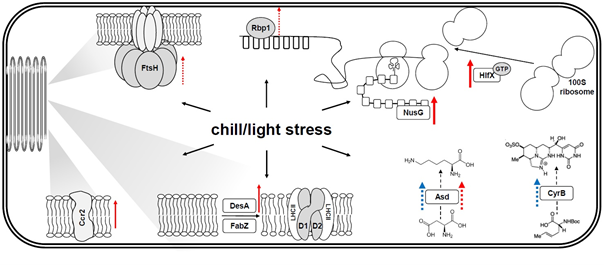
This study aims to provide understanding of the adaptive potential of R. raciborskii and other bloom-forming cyanobacteria in terms of flexible physiology and new gene acquisition. The question to be answered is how the R. raciborskii strains adapt to given environmental conditions and how such conditions can influence their invasive character. Thus, the aim of the project is to investigate comprehensively the adaptation mechanisms of this cyanobacterium, including genetic, biochemical, physiological and environmental backgrounds (Antosiak et al., 2020).
The project (carried out in cooperation with M. Kokociński from UAM, Poland and Anusuya Willis, Australian National Algae Culture Collection, Australia), combines a set of laboratory-based experiments and a field sampling campaign as well as chemical, morphological and next generation RNA sequencing analyses supplemented by sophisticated physiological analyses. The study will provide insights into how R. raciborskii strains manage under the chill/light stress.
Determination of organic compounds stability under various physio-chemical factors
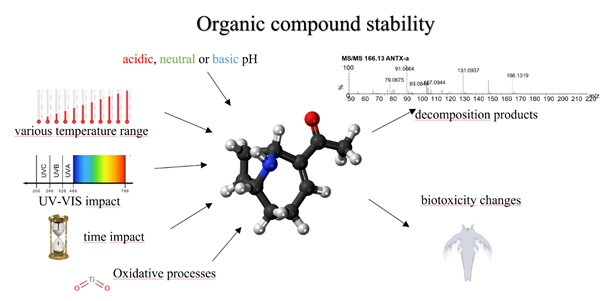 Nature and man are the sources of various chemical compounds. By determining the stability of these compounds in various physio-chemical factors we can propose technological solutions for their accelerated elimination from the environment. On the other hand, we can limit the degradation of beneficial compounds. In my research, I most often check the influence of a wide range of pH, temperature, PAR and UV radiation, time, and photosensitizers (TiO2).
Nature and man are the sources of various chemical compounds. By determining the stability of these compounds in various physio-chemical factors we can propose technological solutions for their accelerated elimination from the environment. On the other hand, we can limit the degradation of beneficial compounds. In my research, I most often check the influence of a wide range of pH, temperature, PAR and UV radiation, time, and photosensitizers (TiO2).
Phytoremediation of freshwater cyanotoxins and not only
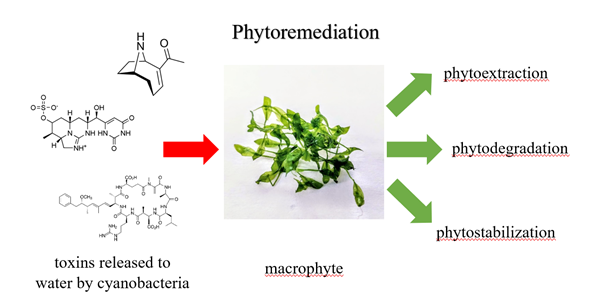 Plants have been used for many years to cleanse the environment of harmful substances. The second of my research topics continued from 2011 is phytoremediation of toxic secondary metabolites synthesized by freshwater cyanobacteria - cyanotoxins. The use of plants not only accelerates the elimination of cyanotoxins from the environment, but also limits or completely inhibits the growth of the cyanobacteria that synthesize them.
Plants have been used for many years to cleanse the environment of harmful substances. The second of my research topics continued from 2011 is phytoremediation of toxic secondary metabolites synthesized by freshwater cyanobacteria - cyanotoxins. The use of plants not only accelerates the elimination of cyanotoxins from the environment, but also limits or completely inhibits the growth of the cyanobacteria that synthesize them.
Impact of xenobiotics on macrophytes
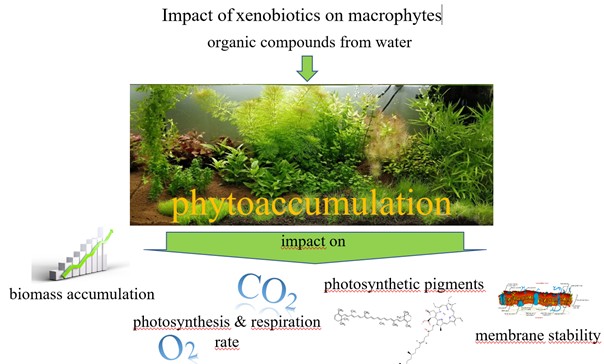
A xenobiotic is a chemical substance found within an organism that is not naturally produced or expected to be present within the organism. In my experiments, I study the influence of xenobiotics on plants: biomass accumulation, rate of photosynthesis and respiratory processes, composition and ratio of photosynthetic pigments, membrane damage, and the ability of macrophytes to bind these compounds.
Allelopathic interactions of epiphytic lichen species and inhabited trees
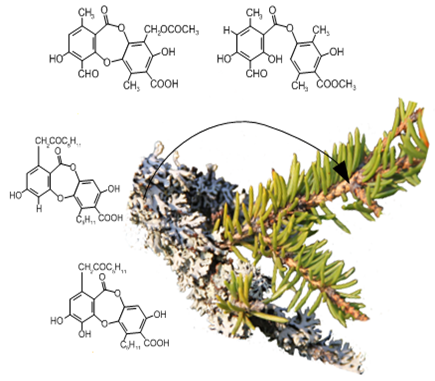 Lichens produce over 800 secondary metabolites with high structural diversity and wide biological activity. In our laboratory, we conduct isolation, identification and quantification of unique lichen substances by high-performance liquid chromatography (HPLC) and mass spectrometry (MS) methods.
Lichens produce over 800 secondary metabolites with high structural diversity and wide biological activity. In our laboratory, we conduct isolation, identification and quantification of unique lichen substances by high-performance liquid chromatography (HPLC) and mass spectrometry (MS) methods.
Secondary metabolites of lichens can be potent allelochemicals in the natural environment. Epiphytic lichen species, such as the common and widespread Hypogymnia physodes, often colonizes a large part of branches and trunk of host-trees. Interesting questions are: whether lichen metabolites can penetrate into the tissues of inhabited trees and how their long-term impact affects the condition of the host tree.
Previously, we detected and identified four major secondary metabolites of H. physodes in the bark of spruce branches (Latkowska et al. 2015a) and showed an increase in the accumulation of plant phenolic compounds in the bark, as well as a decrease in total protein content at sites where thalli had direct contact with the bark (Latkowska et al. 2015b).
Currently, we attempt to investigate the possibility of translocation of lichen chemicals within plant and the effect of these compounds on the biochemistry of inhabited trees.
Heavy metal detoxification strategies in lichens
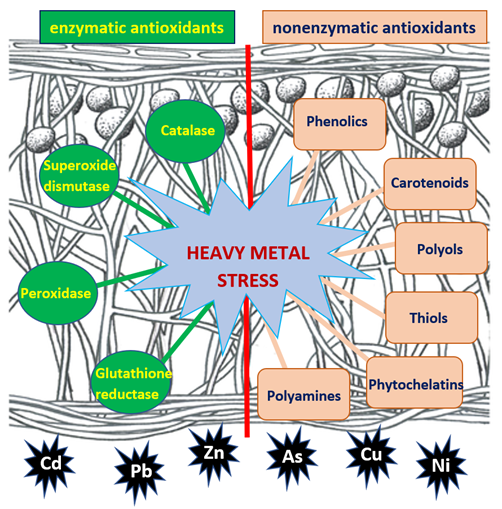 Heavy metals can cause multi-level negative effects on living organisms. In spite of this, there are known some lichen species, such as epigeic Diploschistes muscorum and Cladonia rei, that spontaneously colonize post-industrial wastes strongly polluted with toxic metals. As we determined in our studies (Rola, Latkowska, Myśliwa-Kurdziel, Osyczka 2019; Osyczka, Latkowska, Rola 2021) these lichens growing on dumps of Upper Silesia are well adapted to high concentration of heavy metals in the substratum.
Heavy metals can cause multi-level negative effects on living organisms. In spite of this, there are known some lichen species, such as epigeic Diploschistes muscorum and Cladonia rei, that spontaneously colonize post-industrial wastes strongly polluted with toxic metals. As we determined in our studies (Rola, Latkowska, Myśliwa-Kurdziel, Osyczka 2019; Osyczka, Latkowska, Rola 2021) these lichens growing on dumps of Upper Silesia are well adapted to high concentration of heavy metals in the substratum.
The fundamental question in this theme is: what defense mechanisms, functioning at the level of both, the algal and the fungal partner, are involved in protection the lichen thallus from the toxic effects of heavy metals.
Presently, the objective of our researches is a comprehensive determination of the content of enzymatic and non-enzymatic antioxidants and heavy metal chelators in D. muscorum and C. rei cells in the context of their different heavy metal accumulation strategy in thalli.
